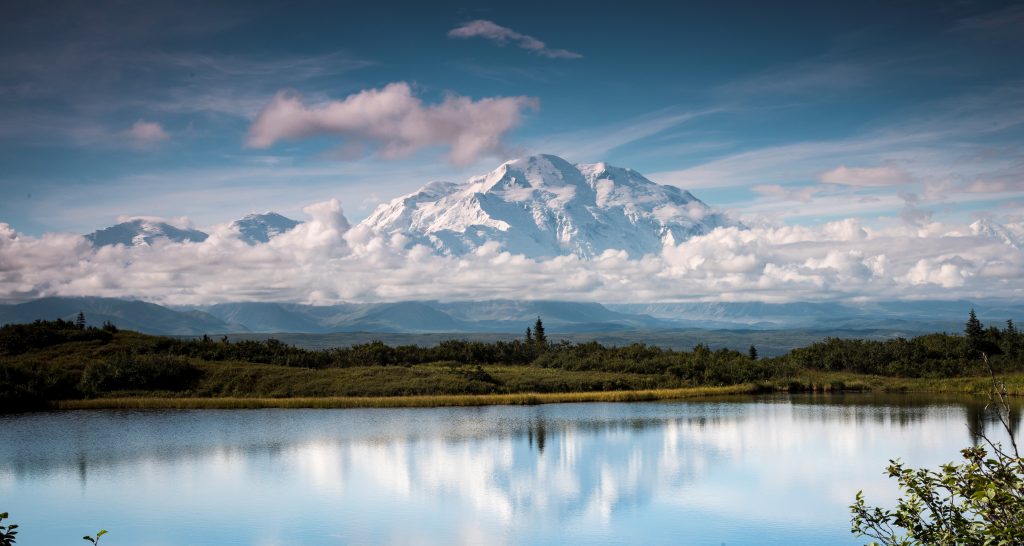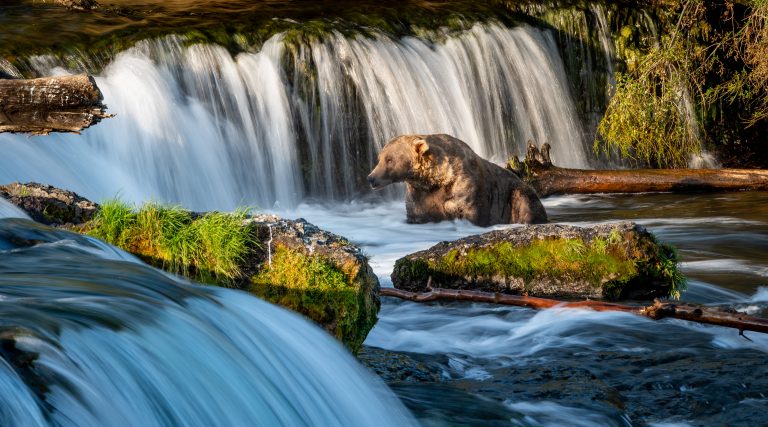A lone bear stakes out his fishing territory beneath Brooks Falls in Katmai, one of eight Alaska National Parks. Photo by Michelle Theall.
This story originally ran in Alaska magazine and is shared here with permission from the author.
Alaska’s eight designated national parks cover over 41 million acres. For scale, that’s twice the size of all of the Lower 48 national parks—from Death Valley to Big Bend—added together. National parks are considered the crown jewels of each state—important enough to be protected for all—and Alaska is no exception. It just, well, has a bigger crown.
Alaska is romanticized and revered for its wildness, its vast and forbidding landscapes, and its almost mythic number of creatures. The diverse flora and fauna here exist among famous mountains, but also unnamed and unclimbed peaks and salmon-rich rivers and remote streams. There’s a reason these areas are protected: their wild beauty and wonder represent the best Alaska and, thus, our country, has to offer. Visiting all of the parks requires some logistical gymnastics—ideally broken down into a few trips to the state. Rest assured, Denali, Lake Clark, Katmai, Kenai Fjords, Kobuk Valley, Gates of the Arctic, Glacier Bay, and Wrangell-St. Elias will be waiting.
Kenai Fjords National Park
Using Anchorage as your hub, tackle Kenai Fjords National Park on the Kenai Peninsula first. Rent a car and drive the national scenic byway of Seward Highway, enjoying Turnagain Arm, Portage Glacier, Girdwood, the Alaska Wildlife Conservation Center, and Moose Pass along the 2.5-hour drive to Seward. You’ll be tempted to hang out in Seward to take in the exceptional views of Resurrection Bay, but at some point, board a cruise with Major Marine Tours or Kenai Fjords Tours to spend the day exploring the 600,000 acres of Kenai Fjords National Park by catamaran. More than 38 glaciers and fjords flow out of the massive Harding Icefield; the area is a refuge for orcas, humpbacks, puffins, Dall’s porpoise, Steller sea lion colonies, harbor seals, and bald eagles. Bonus: Most boat tours include a stop at a calving glacier.
Katmai and Lake Clark
Anchorage is also a great jumping off point for two national parks on the Alaska Peninsula: Katmai and Lake Clark, which are both less than two-hour flights from the city. At Katmai, you can fly in and out the same day, or try to land a reservation to camp or rent a cabin at Brooks Camp and stay a while. Brooks Falls remains an iconic (and crowded) bear-viewing mecca for photographers and wildlife lovers, especially in July and September, when the bears congregate by the dozens to fish for spawning salmon beneath the waterfall. In addition, Brooks Camp offers day tours to Valley of Ten Thousand Smokes, an otherworldly landscape of craters, steam vents, and ash-covered mountains. Lake Clark, also renowned for bear viewing, allows day-trippers, but has more lodges for those wanting to spend some time exploring without fighting hordes of tourists. Active volcanoes dominate the landscape with lush slopes leading to snow-capped peaks, while brown bears, puffins, moose, wolves, fox, Dall sheep, seals, and even beluga whales make their home in and around the park. Arguably, some of the best fishing in the state can be found here.
Denali National Park

Bucket-listers will want to cross off visiting the highest peak in North America, Denali. Standing 20,310-feet above sea level in Alaska’s interior, the High One makes its own weather system, appearing to only 30 percent of park visitors. Flightseeing tours out of nearby Talkeetna or at the entrance to the park offer the best way to see the mountain and surrounding range and typically include landing on a glacier. You can also drive to Denali, keeping in mind that private vehicles are not allowed past Mile 15, from Fairbanks or Anchorage, or take the train. The best way to see the park by road is to hop one of the shuttle buses and take a round-trip adventure to the end of the 92-mile road and back, stopping for wildlife and panoramic views along the way.
Wrangell-St. Elias
Want to knock off another national park within driving distance of Anchorage? It’s possible to get to Wrangell-St. Elias via McCarthy, if you’re willing to take an epic road adventure and are prepared for road hazards, lack of cell service, and hunger ahead of time. Depending on conditions, the excursion could take up to nine hours or so. Let The MILEPOST® be your guide on this one and watch out for potholes, frost heaves, flat tires, mud, and moose. Stay in the tiny town of McCarthy and take a shuttle into the park to explore the historic buildings of the Kennecott Mine or to hike on the river of ice below Root Glacier. Serious elevation gains lead to the crumbling Jumbo or Bonanza mines.
Glacier Bay National Park
In southeast Alaska, Glacier Bay demonstrates one of the more dramatic examples of climate change, with ice receding more than 65 miles in 200 years. It’s possible to stay in Gustavus, the small town near the park, or at the Glacier Bay Lodge in Bartlett Cove, but most visitors will tour Glacier Bay by cruise ship. The massive Fairweather Range provides the backdrop for seals on ice floes, multi-story calving glaciers, noisy and rambunctious sea lion colonies, and the convergence of ecosystems adjusting to warming temperatures in this three-million-acre park.
Gates of the Arctic and Kobuk Valley

The last two parks are in the northern part of the state. They’re difficult and remote wilderness areas without any maintained trails or developed facilities and contain multiple river crossings. Some might say, Gates of the Arctic and Kobuk Valley make Alaska…Alaska—with uninhabited vast beauty covering millions of acres. To reach Gates of the Arctic, you can take a flight from Fairbanks to two of the gateway communities to the park, the Native village of Anaktuvuk Pass or Bettles. Other flight operators and tour companies can arrange for drop off and pick up farther inside the park, to reach places known for endless solitude, serrated peaks, and wildlife, including bears, wolves, and caribou. To reach Kobuk Valley, consider booking a tour out of Ambler to raft the Kobuk’s rivers or camp on the famous sand dunes. Three sets of dunes cover more than 20,000 acres, with drifts up to 100 feet high. Twice per year, more than half a million caribou migrate across the park, traversing dunes and bluffs atop fossils dating back to the Ice Age.



Comments are closed.